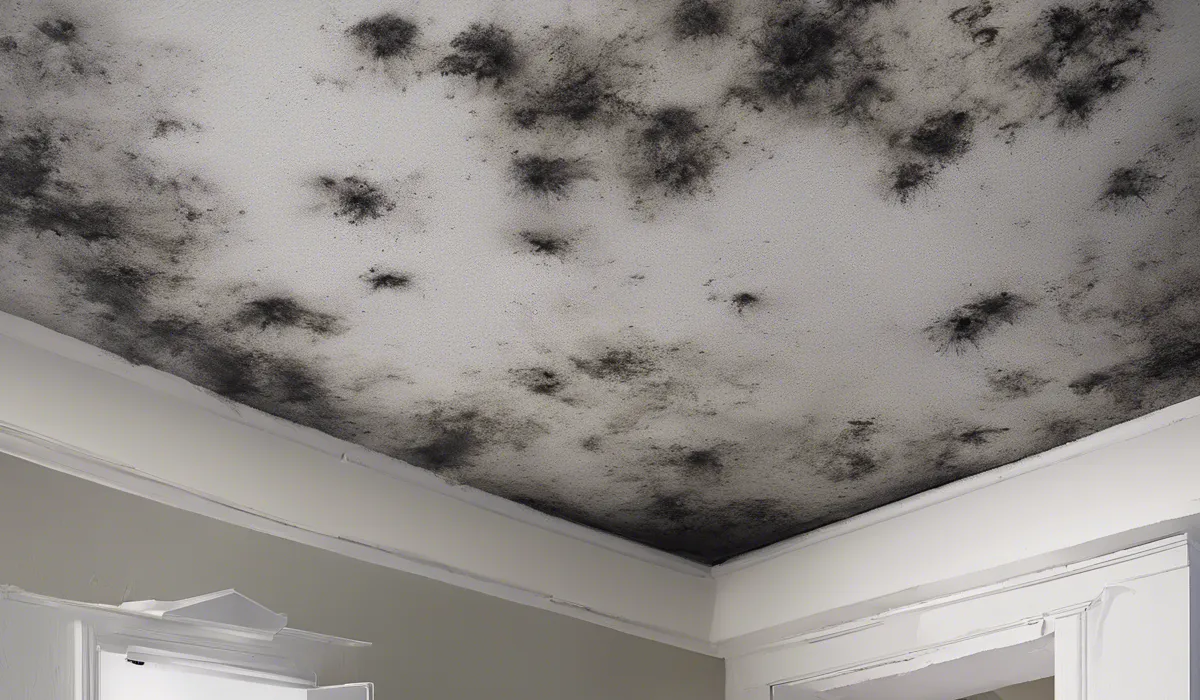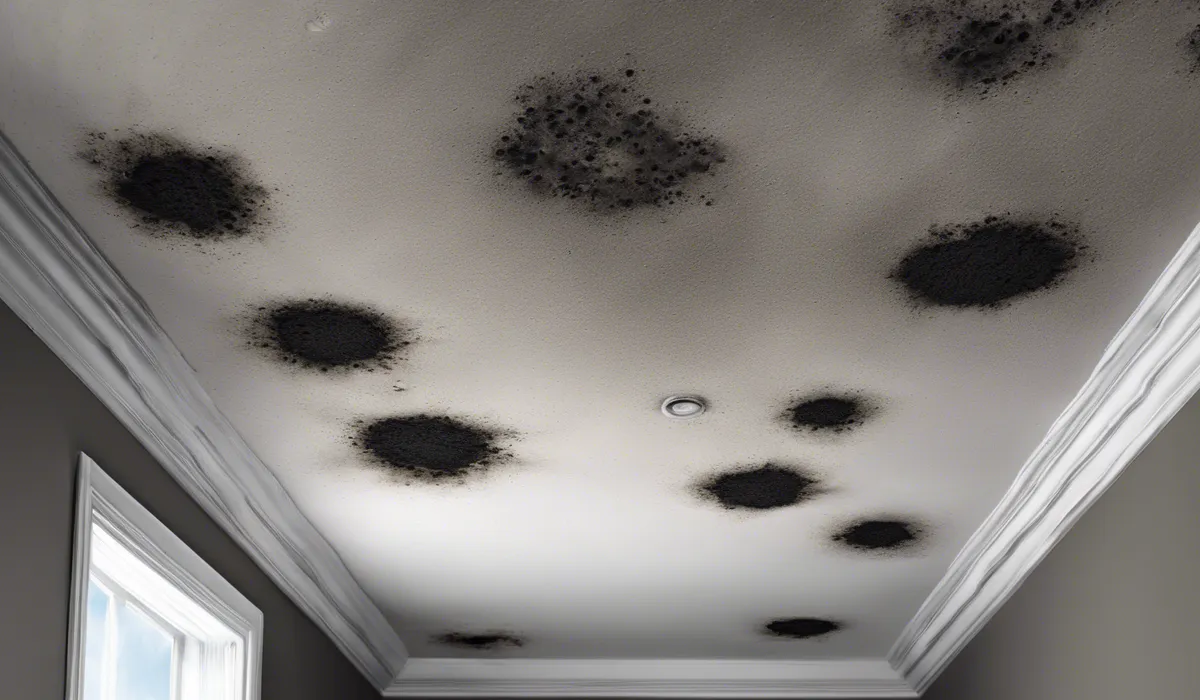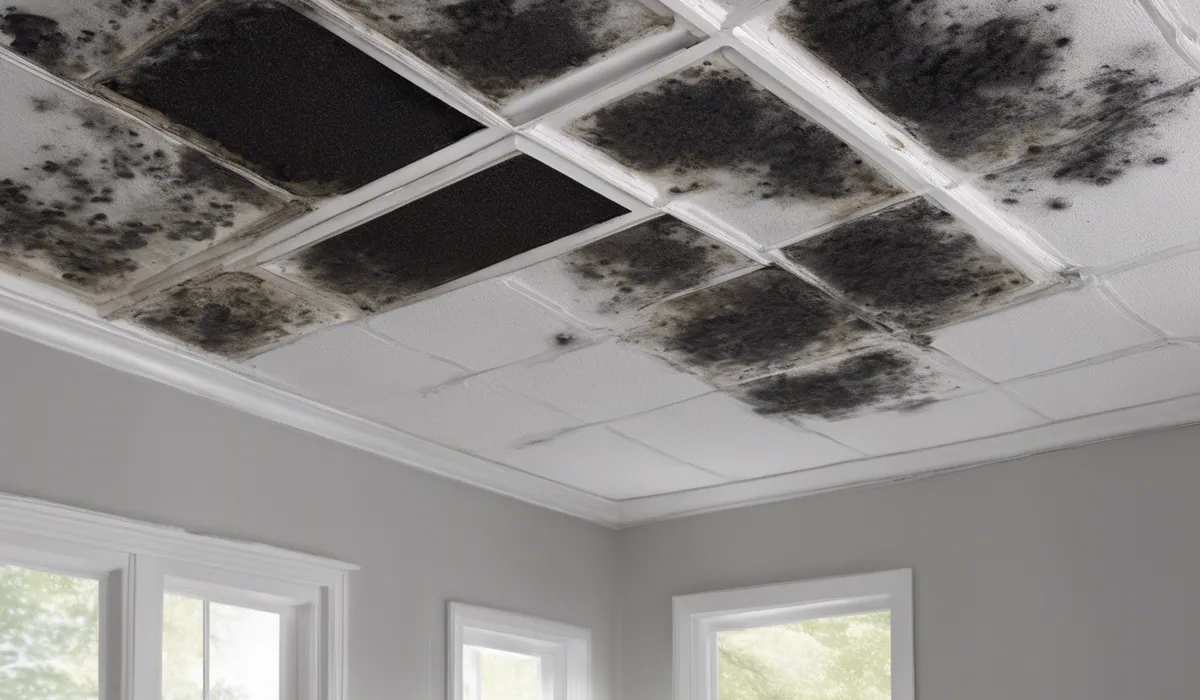Yes, black mold on ceilings is dangerous as it can release harmful spores, causing respiratory issues and allergic reactions. Prolonged exposure increases health risks, particularly for vulnerable individuals. It’s crucial to address any black mold infestations promptly and safely.
Understanding Black Mold

Definition and Identification of Black Mold
Black mold, scientifically known as Stachybotrys chartarum, is a type of fungus that thrives in damp, warm, and humid conditions.
This mold appears as dark black or greenish-black patches and can have a slimy texture. It emits a musty, earthy smell, often the first sign of its presence before it becomes visible.
Identifying black mold involves looking for these distinctive characteristics in areas prone to moisture build-up.
Conditions Leading to Black Mold Growth
Black mold on ceilings is typically a result of excess moisture, which can come from leaks, condensation, or high humidity.
Poor ventilation exacerbates the problem by trapping moist air. Materials like ceiling tiles, drywall, or wood provide the cellulose that black mold needs to grow.
It is essential to monitor spaces where these conditions are met, such as bathrooms, kitchens, or basements, to prevent mold infestation.
Common Types of Black Mold in Homes
While Stachybotrys chartarum is the most notorious, other molds like Cladosporium, Aspergillus, and Penicillium can also appear black and be mistaken for the more dangerous variety.
It’s important to precisely identify the mold type to assess the potential risks and determine the correct removal strategy.
Differences Between Black Mold and Other Molds
Unlike common molds that might cause mild irritation, black mold is known for producing mycotoxins that can lead to more severe health issues.
It is denser and sticks more firmly to surfaces, making it harder to remove. Knowing these differences is crucial for proper mold management and ensuring safety.
Health Risks Associated with Black Mold Exposure

Short-term Health Effects
Exposure to black mold can cause various short-term health effects such as coughing, sneezing, sore throats, itchy eyes, and skin rashes.
These symptoms are particularly pronounced in individuals with allergies or asthma, as mold spores can trigger allergic reactions and asthma attacks.
Long-term Health Risks
Continuous exposure to black mold may lead to more severe health risks like chronic respiratory illnesses, persistent headaches, fatigue, and immune system suppression.
In extreme cases, exposure can lead to toxic mold syndrome, with symptoms that are harder to reverse and may require medical intervention.
Vulnerable Populations
Individuals with pre-existing respiratory conditions, the elderly, infants, and those with compromised immune systems are especially vulnerable to the harmful effects of black mold.
For these groups, even minimal exposure can result in significant health complications.
Symptoms of Black Mold Exposure
Recognizing the symptoms of black mold exposure is vital. Look out for persistent coughing, wheezing, nasal congestion, irritated eyes, or skin rashes.
More serious symptoms include memory loss, dizziness, and prolonged fatigue, which require immediate attention.
Research on Black Mold and Health
Studies have shown a correlation between black mold exposure and health issues. Research findings reinforce the importance of promptly addressing any black mold presence to mitigate potential health risks.
Remediation and Prevention of Black Mold on Ceilings

Professional Mold Assessment
Engaging a professional for mold assessment and testing ensures accurate identification and effective treatment strategies.
Experts can evaluate the extent of mold growth and recommend the best course of action for removal and prevention.
Safe Removal Steps
Safe removal of black mold involves sealing off the affected area, using protective gear, and employing specialized cleaning agents.
Professionals use HEPA vacuums and air scrubbers to prevent spore spread during the remediation process.
Addressing Moisture Sources
It is crucial to address the underlying moisture problem that led to mold growth. This may involve repairing leaks, improving insulation, or installing dehumidifiers to control humidity levels in your home.
Prevention Strategies
Preventing future mold growth requires maintaining a dry environment, ensuring good air circulation, and promptly addressing any water damage.
Use exhaust fans, open windows, and consider mold-resistant products for high-risk areas.
Maintaining a Mold-Free Environment
Regular cleaning, monitoring humidity levels, and inspecting for water leaks are best practices for a mold-free home. Stay vigilant to the signs of mold and take immediate action if growth is detected.
FAQs About Black Mold on Ceilings
Is black mold found on ceilings harmful to everyone?
Yes, black mold on ceilings can release spores that are harmful to everyone, but it poses a higher risk to individuals with respiratory conditions, allergies, or compromised immune systems.
Can black mold on my ceiling make me sick?
Yes, exposure to black mold can cause respiratory issues, allergic reactions, and in some cases, more severe health problems, especially with prolonged exposure.
Should I remove black mold on my ceiling immediately?
Yes, it’s crucial to address black mold infestations on ceilings promptly to prevent health risks and further spread.
Is it safe to clean black mold from a ceiling by myself?
Small areas of mold can sometimes be cleaned by yourself using proper safety gear and mold removal products, but large infestations should be handled by professionals.
How can I prevent black mold from growing on my ceiling?
Preventing black mold involves controlling humidity levels, ensuring proper ventilation, promptly repairing leaks, and keeping the area dry and clean.
Final Thoughts
Black mold on ceilings poses a significant health hazard, releasing spores that can lead to respiratory problems and allergic reactions.
It’s especially dangerous for those with weakened immune systems or pre-existing conditions. Quick and effective remediation is essential to mitigate the associated health risks and ensure a safe living environment.
